Shopify: A StarCraft Inspired Business Strategy
How CEO Tobi Lütke Applied StarCraft Gaming Strategies & Concepts To Build Shopify
Welcome to the Nongaap Newsletter! I’m Mike, an ex-activist investor, who writes about tech, corporate governance, the power & friction of incentives, strategy, board dynamics, and the occasional activist fight.
If you’re reading this but haven’t subscribed, I hope you consider joining me on this journey.
Update: “Upgrade complete” (Yes, that was a StarCraft joke.) Thanks for reading Tobi!
Original Post:
Shopify’s CEO Tobi Lütke was once asked: People are starting to characterize Shopify as the next Amazon. Is that the right lens to view your strategy?
His answer (paraphrased):
I get this question a lot, the press loves it. I’m not thinking about it like this. Amazon sells things. Shopify doesn’t. We work well together. We have an Amazon channel. We offer Amazon pay for the merchants who want it, and if anything, Amazon is trying to build an empire and Shopify is trying to arm the rebels.
As a long-time observer of Shopify’s story, I’ve always felt a great way to understand Shopify’s strategy was through the lens of real-time strategy game StarCraft.
This is a personal opinion, but I was reminded of “Shopify is running a StarCraft strategy” when CEO Tobi Lütke (who is a big StarCraft fan that has donated prize pool money to the StarCraft gaming scene) recently live streamed himself playing StarCraft and discussing business.
Given December is the busy holiday shopping period for retailers, I figure it would be a great time to write about e-commerce and Shopify. And since I’ve already subjected you to Jeffree Star, writing about Jeffree breaking Shopify felt stale. So instead, I’m going to write about Shopify and its StarCraft inspired business strategy.
StarCraft
It also doesn’t hurt that writing about Shopify’s strategy is an excuse to write about my favorite esport StarCraft (specifically StarCraft 2). I personally don’t play the game anymore (played the original 20 years ago), but the gameplay and evolving strategies are still really fun to watch. (Side note: There’s some really cool AI gameplay innovation occurring here as well.)
For those unfamiliar with StarCraft (newbie guide and apologies to StarCraft fans for the poor, abbreviated explanation), it is essentially a sci-fi warfare video game where you can play as one of three races (Terran, Protoss, Zerg).
There are various kinds of games you can play, but StarCraft is primarily known for its 1 vs. 1 gameplay where you and your opponent start on opposite sides of a map with each player given one base and equal access to resources.
As a player, your job is to:
Acquire resources.
Use those resources to build production facilities and more bases.
Use the production facilities (and more resources) to make fighting units and/or expand territory (to acquire more resources, for offensive/defensive positioning, grow economy, etc.).
Take the army you’ve built and use it against your enemy by attacking their resources, production facilities, or army.
StarCraft is like a constantly evolving game of chess with incomplete information about the opponent’s layout, pieces, and attack/defense strategies. You must continually “read and adjust” your go-to-battle strategy as you learn more about your opponent’s positioning, buildings, and army composition. It’s an iterative loop.
Needless to say, from a business and investing perspective, I think you can learn a ton watching/playing StarCraft, but you don’t have to take my word for it:
I firmly believe that I learned more about building businesses from playing Starcraft than I've learned from business books - Shopify CEO Tobi Lütke
Note: Tobi Lütke auto deletes tweets after 1 year so I’ve transcribed or screenshot tweets relevant to this post. Normally I’d link directly to the tweet. Apologies if there are errors.
Shopify’s CEO thinks highly enough of StarCraft skills to offer a former professional player an internship on the spot on Twitter.
I suspect SeleCT got a pretty solid referral to Shopify.
StarCraft Strategy
In order to better understand how StarCraft inspired Shopify’s business strategy, we need to understand the 3 major layers of the game: Micro, Macro, and Meta.
Micro Layer: This consists of the game’s units and unit composition. You can build resource harvesting units at the expense of having a smaller army to defend yourself. Or you can build a larger army at the expense of a smaller economy. There are pros and cons to each approach.
Get too greedy and the opponent may show up with a huge army and destroy you. Get too aggressive building an army and the opponent may build a “defensive” base, fend you off, and use their larger economy to build an army that overwhelms you later in the game.
Each unit type has strengths, weakness, and counters. If your opponent is building a certain kind of army, you can build an army that counters that composition. Conversely, you can elicit a certain kind of response from your opponent by “showing” a certain type of army in early skirmishes, and quietly build a counter to the counter army they’re building. It can get quite circular and meta quickly.
Macro Layer: Macro is all about the bigger picture and how you manage and prioritize your production, expansion, and upgrades (yes, you can also upgrade the attack/defense stats of your units which makes certain units worthless later in game or initially worthless units quite powerful later).
The goal is to have the superior macro economy to create more powerful battle units than your opponent. That said, there’s a whole in-game feedback loop that will influence pace of production facility builds, when to expand, and how offensive/defensive of a game a player must play.
Meta Layer: Meta is where the magic is. Meta represents the strategies that optimize the interplay between the macro and micro layers. Each race in the game has strengths and weaknesses that feed into the meta. This, in turn, creates well known “playbooks” and build orders to maximize the odds a player can win the game.
The playbook is constantly evolving and takes the meta outside the game as players anticipate and attempt to disrupt popular macro and micro gameplay tactics, and at its most “meta” play against their known playing style to throw off the opponent. The meta and strategies are constantly evolving in response to the prevailing “winning” approach.
StarCraft is a game of perpetual feedback loops and self-improvement. The playbook is constantly shifting and the game makers are constantly tinkering with the game mechanics to ensure a certain level of “balance” as players attempt to identify and exploit advantages/disadvantages in the game. (This is a lowkey big tech regulation joke)
Zerg: The Ecosystem & Swarm
Remember how I mentioned you can play as one of three races (Terran, Protoss, Zerg)? Tobi Lütke is a Zerg.
For those that not familiar with the races in StarCraft, think of Zerg as the “swarm” race that is collectively stronger by being part of a group. It’s easy to defeat an individual Zerg unit but you’ll be overwhelmed by a swarm. That’s how most Zerg players win the game.
Zerg is an amalgamation that lives within an ecosystem called the “creep” (think of it as a living carpet that slowly expands across the map) which gives Zerg units enhanced abilities and players visibility into oncoming threats when enemies step “onto the creep”. Zerg thrives on this living, evolving “creep” (See pic below. “Creep” is the dark grey area surrounding the blue “resources”).
The Zerg race gets stronger as the game progresses and as their “creep” spreads across the game’s map. A large coverage of “creep” on the map makes it possible to add more facilities (most facilities can only build on “creep”), access more resources, and deploy “swarms” (units only spawn on “creep”) to attack the enemy.
Why does this matter? Because it’s fun! But also…

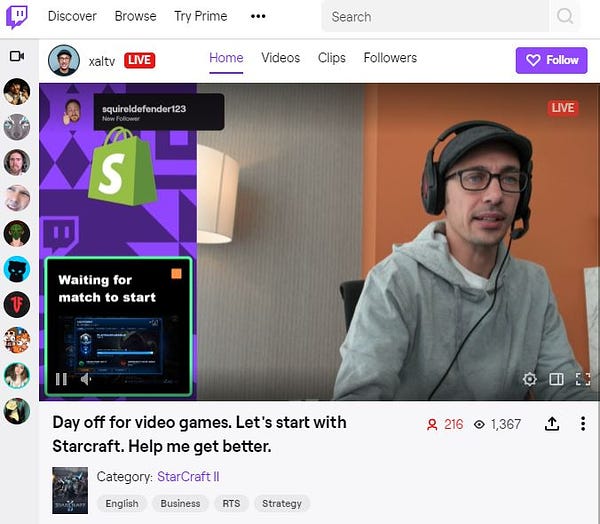

Shopify has turned independent e-commerce sites into an online retail swarm capable of taking on much bigger players. The Shopify ecosystem makes it very easy for entrepreneurs to “spawn” sites and gives them the tools to be nimble and competitive online.
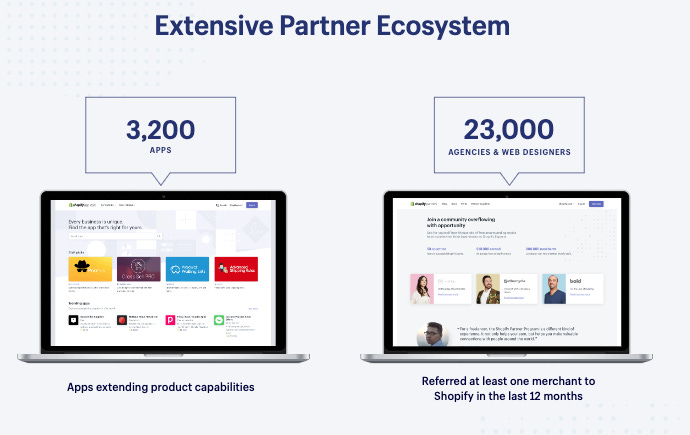
Where most see “One Platform, Every Channel, Any Device”, I see Shopify “Creep” that’s spreading across the commerce map and getting exponentially stronger as it expands.
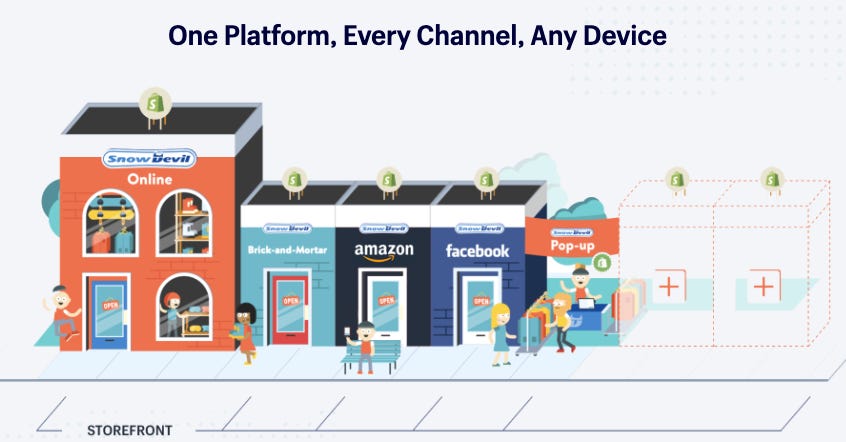
One thing about Zerg gameplay that I haven’t mentioned is many non-Zerg StarCraft players get frustrated in long games because Zerg is extremely difficult to beat in “late game”. This means once a Zerg player has established their macro economy and upgrades, they can pretty much win any “read and respond” situations as long as they build the appropriate counters-measures in a timely fashion.
Consequently, in order to win, you have to beat Zerg early in the game or you will likely lose a long game of attrition all else being equal.
In my opinion, Shopify is well past the “early game” stage of online commerce so it will be interesting to see how things play out for Shopify long-term.
Interestingly, in November 2018 someone on Twitter predicted that Amazon would acquire Shopify in 2019. Tobi Lütke responded with the most “late game Zerg” response ever:
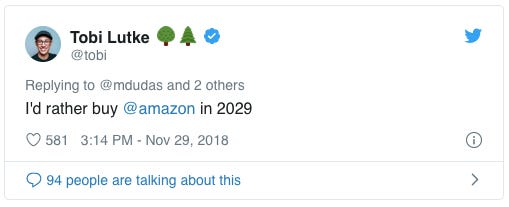
I don’t think we’re anywhere close to “late game” in online commerce, but I suspect Tobi Lütke’s tongue-in-cheek reply will look not so tongue-in-cheek in 2029.
Interview With CEO Tobi Lütke
Tobi Lütke recently did an interview with Dan Martell which I feel really highlights my “Shopify is running a StarCraft strategy” opinion. I definitely encourage you to watch the interview for yourself.
I’ve paraphrased (emphasis on paraphrase…this is my interpretation of what I think he’s saying and I may be completely off) the key takeaways from the conversation and supplemented them with my “StarCraft strategy” takes.
On Engineering and Building World Class Product
Shopify doesn’t necessarily do anything different from what most companies do. Programming is very important, but coming from a self-taught background and not traditionally trained, Tobi Lütke also values and has a wide interest in many topics.
Tobi is constantly asking questions about the world and explores those questions. Sometimes the “answer” to a question involves reading a book, but in the particular case of Shopify it required building a Company.
When Tobi Lütke was first building an online snowboard store, he constantly kept asking: Why is it so damn hard to build an internet company? Didn’t we build the Internet so everyone can do their own thing on it?
Philosophically, building a business is one of the purest forms of self-expression, but it was incredibly difficult to build online. This shouldn’t be the case.
The question is: What would happen if someone made it easier to start an online store?
Following these questions of building an easier online store ultimately led to the journey of creating and building Shopify.
Tobi describes himself as a product technologist and takes pride in being a generalist. By constantly asking questions and drawing from many fields to find solutions, Shopify is able to sustain world class engineering and product.
My StarCraft Take: StarCraft is a game of constantly asking questions with the answer often times creating another set of questions. What is my opponent doing? How should I respond? What should I do to pre-empt my opponent? The opponent has responded to my response. How do I respond to their counter? Do I stay the course or change?
Like StarCraft, Shopify is iteratively answering questions by building solutions that in turn create a new set of questions to answer.
On Approaching Problems and Prioritization
For the last 15 years, Tobi Lütke has been obsessed with the question of how to build software for entrepreneurs who aren’t technologists.
Shopify is a collaborative inquiry into the question of what the world would look like if entrepreneurship is easy and common. It is Tobi’s belief the world could be a cooler version of itself if entrepreneurship is easier.
The key question Shopify continually asks is: What sucks about starting an online business?
The answer to that is the next thing to work on.
My StarCraft Take: Shopify is playing a continuous game of “read and respond”. Anyone is capable of reading and responding, but the key to really shining is obsessing over both the question and the answer. Most players, and companies, stop at the initial cursory solution instead of thinking about the solution that maximizes both near and long-term success.
On Addressable Market
~10 years ago Tobi was fundraising on Sand Hill Road pitching VCs to fund Shopify. Many VCs passed on investing because they felt the addressable market for online stores was just too small. At the time, 40K to 50K online stores existed and getting 50% of that market was not a big enough business to justify a VC investment.
Recently (and with 1M merchants on the Shopify platform), Tobi met with one of the VCs that passed on funding Shopify and they asked him what did they miss? His response was that the VC actually had it “right”, but what they didn’t realize was Shopify is the solution to the very problem they identified. The reason there was only 40K to 50K stores was because it was too hard and expensive to deploy an online store. Shopify made things accessible and simple to do.
My StarCraft Take: The game meta for StarCraft is constantly changing because players are constantly trying to find new ways to break status quo strategies and reset to a new equilibrium. StarCraft players don’t assume the equilibrium is “static” and immutable. Companies and investors occasionally get too static with their views of Addressable Market and fail to realize changing the game meta (making it easier to start an online store) can unlock a much larger market.
On Post-Product/Market Fit Challenges
What happens a lot in post-product/market fit companies is they fail to reach the next level (i.e. achieve their larger ambitions), because they adhere to pre-defined industry swim lanes.
When Shopify entered e-commerce, there were already a ton of competitors (possibly 1,000s) and vendor options (open source, enterprise, etc.). The problem (and Shopify’s opportunity) is they all tried to service the same customers (existing e-commerce/retailers) and approached the market through the same entry point.
Existing customers had a lot of money whereas entrepreneurs had no money so the market went to where the existing money was (existing retailers). Shopify entered a crowded space with the one major difference being they focused on entrepreneurs, and it turns out entrepreneurs were a much larger market vs. existing retailers.
In fact, the vast majority of the top 10 fastest selling Shopify stores started on Shopify. They aren’t existing retailers that migrated over.
My StarCraft Take: Sometimes the best way to win a game is to do the complete opposite strategy of your opponent. If you scout the opponent and see they are heavily focused on building their economy and air units (which are powerful units and can win “late game” but are resource intensive, takes a long time to produce, and are slow moving), the best course of action is nimbleness, building faster (but “weaker”) units that can overwhelm multiple locations, and replenish quickly.
On Evolving Product Roadmap
The continuous approach of thinking about and solving customer pain points led Shopify to a completely different segment of the market from e-commerce. The Company started integrating into physical POS, social channels (Instagram), and is now introducing logistics.
Over time, Shopify has evolved from just shopping cart software into a multi-channel software Company where customers give Shopify their products and then sell it everywhere. No other competitors in e-commerce followed Shopify as they took this route.
Shopify’s product roadmap is not based on adhering pre-defined industry swim lanes, but following a question as far as it goes. It is very important to build a company that has the self-confidence of a mission or to pursue a question. Otherwise, you self-confine yourself to a local maxima.
My StarCraft Take: In StarCraft, there’s an online ranking system system called the “Ladder” where players are rated and put into divisions (with players of similar skill level). The goal is to move your way up the ladder, improve your ranking, and get promoted into higher tiered divisions. Players can get quite far sticking to a certain “playbook”, but inevitably plateau if they don’t learn to properly “read and respond” and develop new strategies. Anyone can memorize the best way to build an army, but it takes an ability to think on your feet, be creative, and constantly ask questions to be good at StarCraft.
On “Machines That Builds The Machine” (The Organization)
As a programmer, you automatically think in systems. Most people by default think in terms of “cause and effect”. The world isn’t linear like that. The world works in systems.
Thinking Linearly: “Going to good school leads to a good job”
Thinking in Systems: “Going to a good school activates your quality of thinking. This reinforces your ability to learn things, and the ability to iterate/loop on a problem is what Companies value.”
As an engineer, you understand this because you have been building systems. They have to reinforce each other.
Company building is about building systems that in turn makes the Company better.
My StarCraft Take: Being successful in StarCraft requires thinking in systems, being able to iterate both in-game and over time to become a better player, and taking a holistic approach to game strategy. Memorizing answers can only take players so far. The key is to learn to solve challenges as they arise and evolve in game.
On How Companies Get Better
You need to add good people but existing people need to get better as well. A lot of it is culture.
Learner’s organization is a core part of Shopify’s identity and why the Company has a fairly sizable “coaching staff” (talent acceleration). Talent acceleration consists of 50 people (out of 4,000 employees and contractors).
A Company is a collection of people. If you want to be a better Company, help your people achieve personal and professional breakthroughs.
Shopify is a better Company by helping their people have eureka moments in some meaningful way. It’s not about making one choice better, it’s about that person making every choice better.
If you 1) figure out the loops and systems that ratchet up the quality of thinking and decision-making year-over-year, and 2) do it in a consistent way, the Company will eventually become unbeatable.
My StarCraft Take: I’m telling you, Tobi Lütke is building towards “late game” Zerg at Shopify. The key to being unbeatable in the game is to build up the infrastructure to gather resources quickly and continuously “upgrade” your units to produce a superior army.
On The Challenge of Organizational Growth
In a Company that’s growing 50% year-over-year, people need to get better at their job by 50% just to stand still. If you want to grow and go further in the Company, you must outpace the growth of the Company. That’s tough to do and requires commitment.
Core Shopify values such as being a learner’s organization, making great decisions quickly, thriving on change, and thinking of the long-term also serve as a warning label. Shopify isn’t for everyone, but it’s intoxicating for the people that sign up for the job.
My StarCraft Take: Sometimes the best units to produce early on in a game of StarCraft are useless (and potentially detrimental) later in the game if you are not continuously upgrading their stats in the game. Great players are continuously looking to upgrade their existing armies to maintain an edge.
Furthermore, it requires hours of grinding and repetitive gameplay, review, and iteration to be a top tier StarCraft player. You must be committed to be great.
On Harley Finkelstein (Shopify COO)
Tobi met Harley Finkelstein at an entrepreneur meet-up where Harley subsequently started using Shopify as a customer. Harley ended up sending more customer service emails than any other person “ever”. He was enthusiastic but relentless with product feedback.
Tobi ultimately made Harley’s account free so he didn’t have to deal with his feedback.
One day, an investor mentioned to Tobi that every person in Shopify was some version of him. It was really good feedback and Tobi knew he needed to figure out how to hire people who were different from him.
Harley was one of the first people that came to mind since he was such a pain in the butt to Shopify. Tobi figured that Harley could be his pain in the butt on behalf of Shopify and recruited him.
Harley’s hire suddenly changed the concept of culture fit and broadened the kinds of people that would thrive at Shopify. A major part of the success of hiring Harley was widening the cultural fit. People who previously couldn’t identify with Tobi’s personality could identify with Harley. The Company ultimately grew into Harley.
Harley’s hire bit-by-bit also made the Company more self-confident.
My StarCraft Take: Different units serve different purposes in StarCraft, but collectively you can create some very powerful armies that overwhelm the opponent by creating an army with complementary skillsets. It’s very easy to fight and counter an army that consists of unit type. It’s an exponentially harder task fighting an army of diverse units with complementary strengths.
On Building a Different Company
How diminishing would it be if you could only recruit from a single subset of people? Tobi believes the more neurodiversity you bring into a meeting, the better the decisions you can make.
Reality is no one knows how to build companies. In the future, we will look back and be terribly embarrassed by the way Companies are being run today.
Why would you try to build a company that’s exactly like everyone else when no one has figured out how to build a business?
This is why it’s such a cool time to build a company today, and Shopify is trying to be a pioneer.
The goal is to build a Company that’s as different as possible. To get a Company that’s “different”, you need to figure out the set of things that matters the most to the Company.
Neurodiversity is something that matters to Shopify. Problem solving dynamically changes for the better when you introduce people who have different life experiences.
Companies also need to figure out what are their “bets”. What are the things you believe that most people don’t agree with?
If you start with the exact same ideas that everyone else has, then you’re inevitably competing with large companies on unequal ground who are much bigger than you and have already done their growth based on those ideas.
My StarCraft Take: One of the most exciting phases of StarCraft is when the game meta changes and long held strategies are torn down with a new equilibrium arising. More often than not, the new meta and tactics are ushered in by differentiated players who do “unorthodox” things. The game meta comes to the differentiated player, not the other way around.
Similarly in business, the key to breaking out and introducing a new meta is to take an opinionated, differentiated approach that runs counter to traditional thinking. You’re not going to beat incumbents with traditional thinking.
On Product Philosophy
What’s important for Shopify’s success in the long-term is to create an environment where an engineer, product manager, U/X person, or R&D person, feels the best way to solve any problem in the world of commerce is significantly easier to solve within Shopify as compared to being a startup outside of the Company.
If that’s ever not true, what are we doing as a Company?
It’s an incredibly high bar because Shopify is trying to outpace the commerce innovation in the field.
My StarCraft Take: When playing StarCraft as a Zerg, the game is exponentially easier if the map is covered with “creep”. It’s much more difficult for Zerg to win when an opponent proactively keeps “creep” small and Zerg restricted to a small part of the map.
Shopify’s ecosystem of merchants, third-party apps, and partners, creates an incredibly vibrant “creep” where any commerce problem should be much easier to solve within this ecosystem than outside of it.
Erosion of the ecosystem is the strategic equivalent as seeing the Company’s “creep” shrink. That can’t happen and in fact it should be easier to solve commerce problems as more merchants and partners join and contribute to the “swarm”.
Happy Holiday Shopping!
I look forward to seeing how Shopify continues to grow and evolve. Shopify will probably require more vespene gas, but the future is exciting.

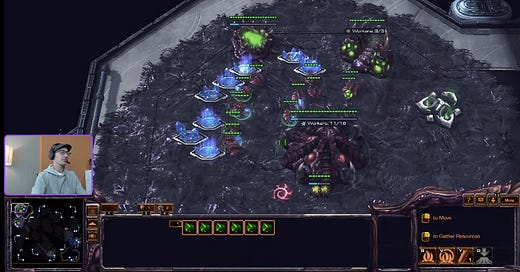



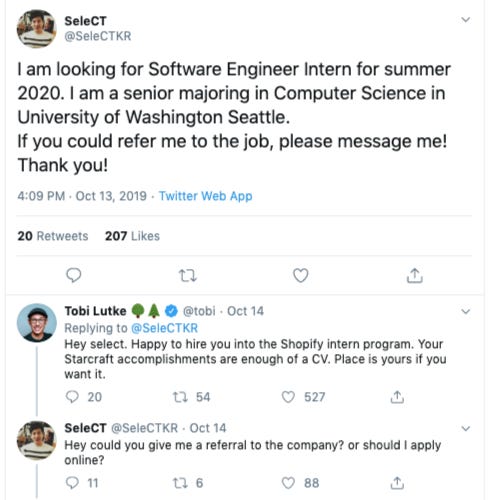


I had to read this one again it was so good. Second order thinking and avoiding the "static equilibrium" mentality is so important and rare. Reminds me of Vox's oral history of Amazon Prime. One exec predicted fast shipping would create a sea of red ink. Bezos: "You aren't thinking correctly." The resulting demand surge would enable more fulfillment centers and lower costs. To paraphrase Bezos, the VCs weren't thinking correctly.
https://www.vox.com/recode/2019/5/3/18511544/amazon-prime-oral-history-jeff-bezos-one-day-shipping
Second order thinking also applies to the public investor side. Amazon acquired Kiva systems for a price that didn't make sense. To make Kiva exclusive to Amazon would destroy ~50% of revenue. If they kept non-amzn customers it was cheaper to remain a customer not an owner. The answer to this strategic conundrum was Amazon was planning a massive expansion of fulfillment centers that would more than justify the acquisition price.